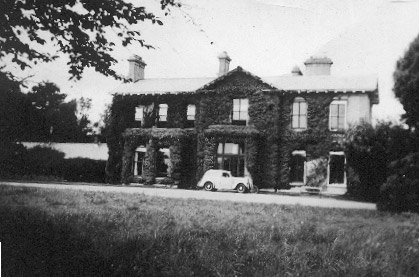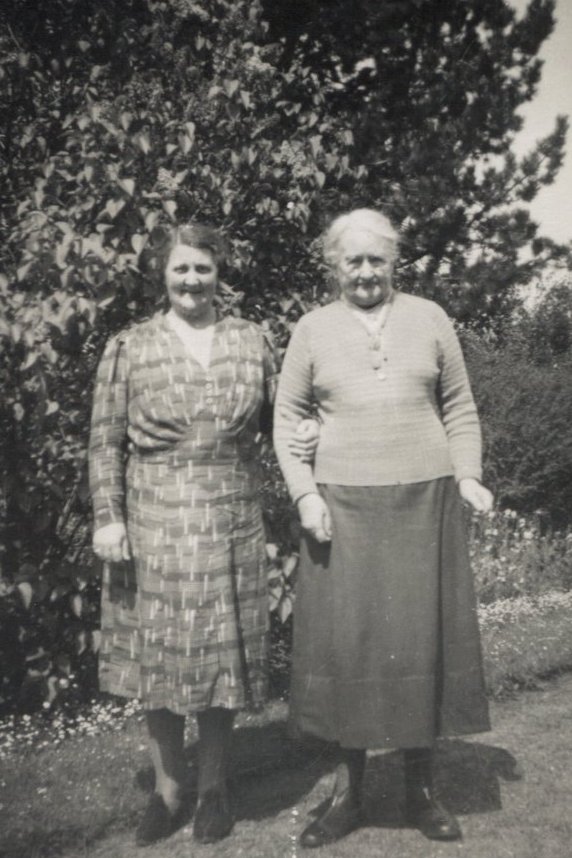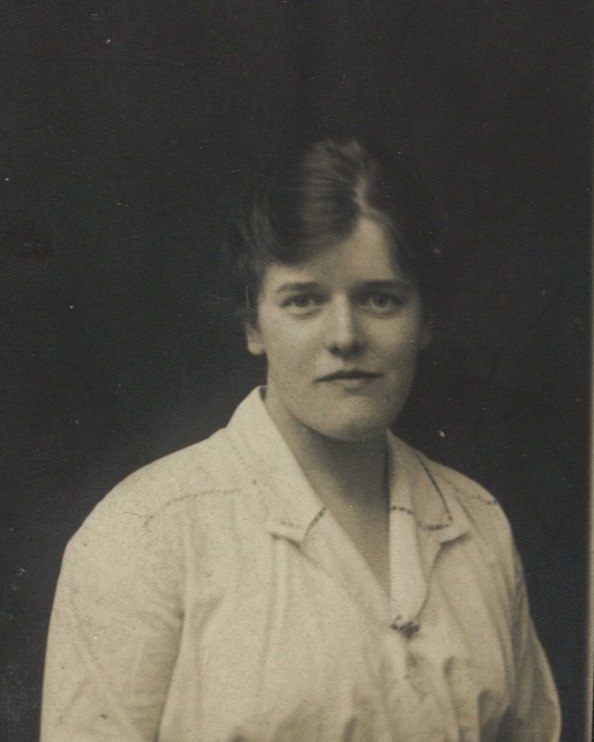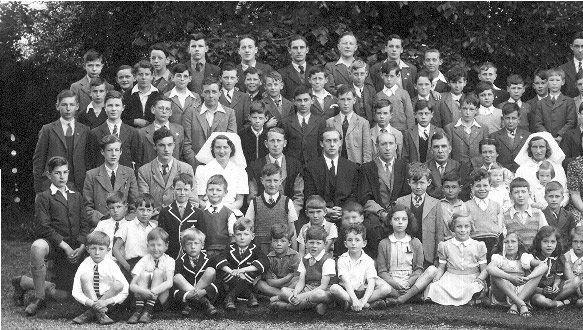Century of Endeavour
The Family in the 1940s
(c) Roy Johnston 2003
(comments to rjtechne@iol.ie)During this decade JJ moved from Charleville, Blackrock, to the Glen near Drogheda for the war, then after the war he moved to a substantial house near Raheny, then to a flat in Avoca Avenue, owned by his brother William, and then to a house in Mount Merrion. I try in what follows to analyse the motivations for this mobility.
The move to the Glen in the summer of 1940 was helped by members of the extended family abroad; JJ wanted for strategic reasons to have access to land, and not to be near a major urban centre, during the war. He seems to have sold some at least of the cousin-hood abroad on its strategic utility as a place of refuge, in a projected 'worst-case scenario'.

The Glen, near Mornington, Drogheda, where JJ and family lived during the war.
My Mother's Family
My grandmother Jenny Wilson had been living in a bungalow in Blackrock, but when we moved to the Glen there was space, and she moved in with us, occupying a room upstairs, where she had a radio; she spent most of her time in bed, though she did get dressed and come down to join the company occasionally.

Granny Wilson and Aunt Isa (Isabel Nesbitt, from Belfast)
During the war we had occasional visits from Uncle Bob Nesbitt and Aunt Isa, who lived in Belfast; their son, my cousin Ian, stayed with us in the Glen often during school holidays, as did my cousin John Younge; my mother's youngest sister Florrie (below) sometimes joined us; she married Jack Younge who worked with the Perry brewery in Rathdowney. Ian, John and I were all of a similar age; we got on well and had various adventures together.

Florence Younge, my aunt, who married Jack Younge; they lived in Rathdowney Co Laois.
The Cousins Rally for the War
There was in fact a substantial rallying of the older paternal cousins in support of the war. This gave rise to some contact with remote ones, eg Tim and Alan who were James' sons, also Geddes, Sam's son who had gone as a gaucho to Argentina. I remember encountering Tim in Charleville, Blackrock, before we moved to the Glen. He had come back from Kenya, and joined the RAF, participating in the defence of Malta; he published a book on this, called 'Tattered Battlements', which I remember reading with interest. Alan we encountered at the Glen; he had been in France, and got out via Dunkirk. After Dunkirk he was stationed in Cookstown for a time, and he came down to the Glen on his bicycle, which he maintained in top-class mechanical condition, gleaming, well oiled and in perfect adjustment. I picked up a feel for mechanical engineering from Alan.Alec (with Geddes and Tommy, Sam's other sons) had been fostered with JJ after Sam's death. They were all off his hands by the time he went to Dundalk in 1928, Geddes abroad, and Tommy and Alec living with Annie in Blackrock. Alec joined the British Army in the mid-30s, in the tank corps, and so when the war came he found himself as a trainer, and managed not to see any action. He married German refugee Klothilde, an opera singer; she and her son Douglas spent time with us at the Glen during the 40s.
Geddes we encountered at the Glen on his way to join the RAF; he brought back a lasso, bolas, and a Spanish chain-mail gauntlet as souvenirs. He was shot down over Libya(1). I regret not having had much chance to interact with him; my sister knew him better; by all accounts he was good company.
During our last summer in Charleville, before we moved to the Glen, I stayed with friends, the Simpsons, who had a cottage at Brittas Bay, and I remember being there, under idyllic circumstances, while the Battle of Britain was going on. We went down there on our bikes, there being no petrol whatever for private motor vehicles.
Boarding School
The move to Drogheda meant that the present writer became a boarder at Avoca School Blackrock, from September 1940 to June 1942, and then at St Columba's College in the hills above Rathfarnham, from September 1942 to July 1946. During the summer term of 1941, with invasion threatening, I was taken out of Avoca and sent to Drogheda Grammar School, which was in reach by bicycle. When in June 1941 the USSR was invaded, the threat of invasion subsided, and I was sent back to Avoca.Boarding at Avoca in the early days of the war was somewhat rough; the junior dormitory was unheated with 3 outside walls and a skylight; we piled our clothes on top of the bedclothes, and resorted to makeshift hot-water bottles. It was interesting to see the motion of the stars through the skylight. On weekends I visited my sister, then newly married and living in Sandymount, easily accessible via the Dalkey tram. The lads, who were mostly day-boys, tended to gang up and play war games; one of them had a German helmet from the first world war. There was a map of Europe in the classroom, with little flags. To our chagrin we had to move them in response to the rapid fall of France and the Dunkirk evacuation.

Extract from the Avoca School group photo, June 1942. The writer is at the back on the left. In the back row also, from left to right, are Gordon Crichton, Peter Archer, Robert Harbord, Hugh Stewart, George Ferguson, Mervyn Searight, (another) and Freddie Newell. George Ferguson went on to become a leading Methodist minister. I have lost track of the others. The full picture is available.
After the Drogheda Grammar School term in 1941 when I went back to Avoca
I was in the senior dormitory, where the physical conditions were better,
but the company was somewhat more rough. We survived, and developed a
robust ability to deal with attempted bullying.
The decision to register me for St Columba's (SCC) I think had been made in the 1930s, because I remember being told so when being primed for going there in 1942. The decision would almost certainly have been made on the basis of my father's philosophical position, rooted in the thinking of Horace Plunkett and possibly Standish O'Grady: the improving landlords perceived as participating in the transformation of their estates into models of development of rural civilisation, based on the co-operative principle.
St Columba's had a farm, and had a positive attitude to the practical arts. It also had a positive attitude to Irish, rooted in the scholarship of the 19th century gentlemen-amateurs of the Academy. I found among JJ's papers a copy of Adare's original prospectus for the school(2). It represents advanced thinking on the part of the Protestant land-owning elite, who saw their role as the leadership of the emerging Irish nation, and embraced the Irish language as a counter to the influence of Rome.
Shreds of this tradition remained; those who went to SCC tended to be the smaller landed gentry; those who could afford to tended to express their Unionism by educating their families in English public schools. It being wartime however the SCC population was swollen by people who would normally have gone to England. There was a good science laboratory, and opportunities for practical extra-curricular activity such as wood and metal workshops, and a blacksmith's forge. There was also a radio workshop, in which I took an interest, having already built a working radio from bits and pieces, mostly inherited from student friends of my elder sister, who had been radio amateurs in the 1930s.
The science lab was run by one George Lodge, a veteran Republican, who had driven the car which rescued de Valera from Parkhurst during the war of independence. He had graduated from the College of Science, being of the pre-first-world war generation of hothouse trainees in chemistry, when the British found that they had been upstaged by the Germans in science-based industry. He was not a good teacher, but if one was interested one could learn from him, and he lent me books which introduced me to the ideas of modern physics, and which pointed me towards physics when I went to College.
The farm helped feed the school, and farm work was an alternative to games. As I was 'off games', due to an accident with a horse at the Glen, I got in with the farm, and the farm committee, which was chaired by Maurice Wigham the biology teacher, subsequently head of Newtown School in Waterford, and a leading Quaker. The practice of managed-estate labour-employing commercial agriculture was along the lines that JJ had been spending his life trying to promote.
The first dawning of Marxist politics I have treated in the political thread; they took place in the relatively sheltered SCC environment, and were at the level of trying to understand rationally what was going on in the world.
The Carmodys Move to Nenagh
We also have my sister's move from Sandymount to Nenagh. Early in the 'emergency' when I was boarding at Avoca I used to visit Dermot and Maureen Carmody in their rented house in Sandymount, near the sea front. Dermot was musical, and I have recollections of singing part-songs at the piano; at that age I would take the soprano line and Dermot would do a creditable tenor. Occasionally we would attend the Christ Church choral evensongs, in which Dermot had a leading role. The choral singing tradition is an important part of the Dublin Protestant cultural heritage.After we moved to the Glen, Dermot got a placement on the Church of Ireland parish network, near Nenagh in north Tipperary. The parishes were Ballinaclough and Templederry. The latter was in the hills, over in the direction of Thurles; there was a Protestant farming community, clustered around Castle Otway, the Otway-Ruthven estate. This had been burned during the war of independence and had not been rebuilt. The family I think mostly remained in Ireland, one member becoming a respected lady historian in TCD. The lore was that they took their compensation money and invested it in urban land.
I have memories of visiting them during the war, with interminable slow train journeys, the locomotive burning damp turf in its boiler designed for coal, and being met by my sister driving a pony and trap. By the same means I recollect visiting Templederry, socialising with the parishioners on the Carmody network, and driving back through the hills by starlight, with Dermot identifying the constellations; he was an amateur astronomer and had an excellent telescope.
My sister was a medical doctor, and she set herself up in private practice; getting a State appointment as a dispensary doctor was unheard of for a Protestant, the medical Establishment being dominated by Catholic doctrinaire exclusivists. She did however manage to buck the system, getting appointed locum from time to time, and remaining in general practice right up to the 1990s, and serving in the 1970s and 80s on the Regional Health Board. During the 'emergency' when she was setting up her practice, her mode of transport was on horseback, being faster than on wheels with the trap. It is a pity she never got around to writing her memoirs. She counted the Bernal family among her patients, and was a source of lore about JD Bernal, on his occasional visits. This was mostly on the 'absent-minded Professor' theme.
The rectory at Ballinaclough had some land, and following JJ's advice they farmed it, employing a local man called Mick; this experience was grist to JJ's agricultural economics mill, and it flavoured his Seanad speeches. When he got back into the Seanad he was able to draw on a petrol allowance of 8 gallons per month, and he bought a Ford Anglia. I recollect helping JJ to navigate the roads from Drogheda to Nenagh, the direct route, avoiding Dublin, without benefit of signposts, these all being removed during the emergency, so as not to facilitate enemy orientation. I had the Bartholomew 1/4 inch maps, and we did the trip without getting lost.
Towards the end of the 'emergency' the Carmodys, as a combination of clergy and medical doctor, became entitled to petrol, and they picked up a rather superior but ancient Armstrong Siddely, which had features like fluid drive and pre-selector gears, but was a glutton for petrol and oil. To get more petrol they taxed another car, a wreck in a Nenagh garage, and the price per gallon worked out exactly at the black market price. This opened up the possibility of some cultural life, which expanded rapidly when at the end of the decade there was an amalgamation of parishes, and they ended up in the rectory in Nenagh town.
RJ in College
From October 1946 I began my period in college, living in JJ's rooms initially in #36, in the New Square, and later in #39 nearby. JJ when in #36 also hosted Paul O'Higgins and Malcolm Craig. He had an extensive suite of rooms on the top floor. Where mostly in TCD at that time there was no plumbing, JJ's rooms were luxurious, in that they had a kitchen sink, and he had a wash-basin put in one of the bedrooms, which I used. He had a lecture room, which he used for his classes, heated by a cast-iron stove. We used this lecture-room for our Promethean Society meetings. In the black winter of 1947, when the snow lay until April, JJ's stove was a life-saver. When he moved to #39 the space was more constrained, and the others had to make their several deals with the College rooms authorities, but I remained there as JJ's lodger. I rarely went home, to my mother's chagrin. The early meetings of the Irish Workers' League executive committee, after it was founded in 1948, took place in JJ's lecture room in #39, thanks to my arranging it. The Neil Goold episode took place there, as reported retrospectively (October 1956) in the Greaves journal.In those days there were few women students, and those who existed were in demand, tending to socialise with the moneyed elite. We as serious-minded visionaries, out to change the world, had little time for the frivolities of the social whirl. We sought women on the basis of shared ideas. Thus originated, from about 1948, my courtship of Mairin Mooney, in the then expanding post-war left-political context. She was a well-read articulate socialist feminist, in the youth movement, with a radical family background; her mother had entered into a second relationship, and fallen out with the Roman Church; her elder brothers Paddy and Steven had become politicised via a period in Britain, with the Communist Party. They subsequently became stalwarts of the Irish Workers' League and the CPI.
We had a good relationship; we went on our bicycles around the youth hostels on weekends and in the vacation; we went camping with the Socialist Youth Movement. On one marathon trip we went to Killarney, staying in the Black Valley hostel, and then up to Limerick and Clare, from which we made the trip home via the Carmodys in Ballinaclough, where we were made welcome. Mairin was on the whole accepted by the family, and was on good terms with JJ, with whom she corresponded on occasion; she was however seldom at ease with my mother, whom she suspected of having upper-crust aspirations, not without reason, I must say. I recollect on various occasions having been invited to meals in the houses of colleagues in school or college, and being cross-examined by my mother as to the interior of the house, and what food was on the table.
Notes and References
1. Folder 85 of the JJ papers contains the Alamein Memorial records, including a photo of Geddes's name on the memorial stone; also correspondence from his O/C relating to the episode on January 22-23 1943 in which Geddes lost his life.2. This document is preserved in Folder 73 of the JJ papers; I have abstracted it in the supportive hypertext.
[1940s Overview] [Family in 1950s]
Some navigational notes:
A highlighted number brings up a footnote or a reference. A highlighted word hotlinks to another document (chapter, appendix, table of contents, whatever). In general, if you click on the 'Back' button it will bring to to the point of departure in the document from which you came.Copyright Dr Roy Johnston 2003